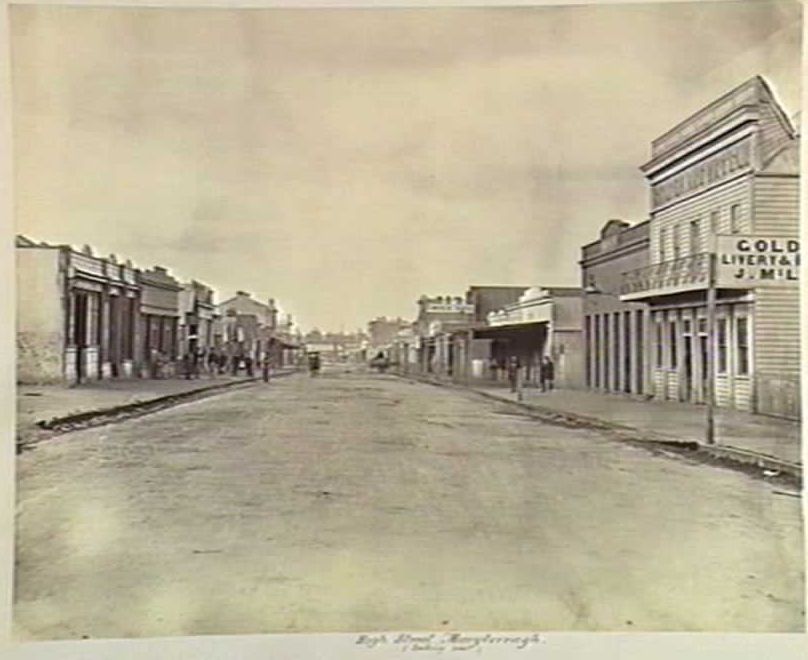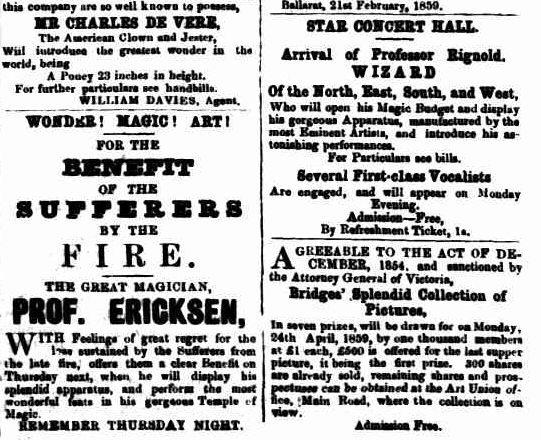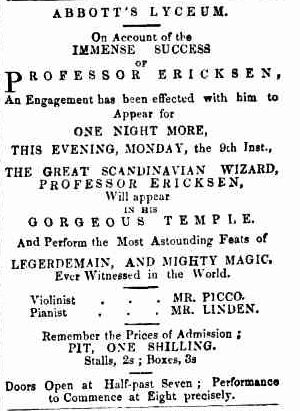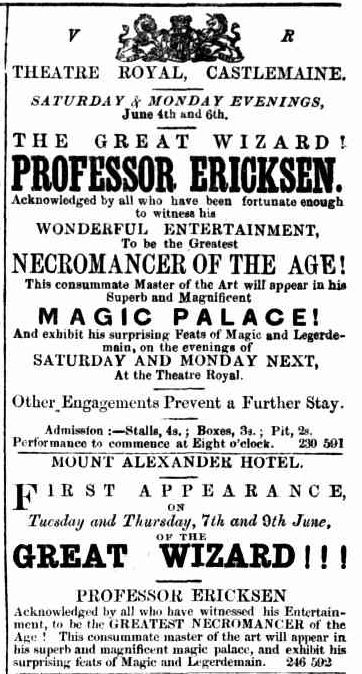Professor Ericksen, the Scandinavian Wizard
There was a frenzied rush of hopeful gold-miners in the mid-1850s, heading for the newly discovered goldfields in New South Wales and Victoria. Amidst the boom and bust, new townships arose and declined, and entertainers made the most of the thriving and raucous social life developing amidst “the rush”. There would be many a performer who toured the goldfields, of whom we have no record except in the larger regions where a newspaper might report on their activities.
Professor Ericksen, the “Scandinavian Wizard”, was one of these. It may well be that he was an existing performer making capital out of the demand for entertainment, or a would-be fortune hunter who turned to performing after failing to find gold. Said the Mt. Alexander Mail (Victoria) in April 1859, “It is certain that many diggers who have gone to the rush unprovided with funds, speedily found that it was a bad place for the destitute. Both butchers and bakers declare that they are asked every day by persons in want to give away meat and bread…. would advise all who are making a subsistence elsewhere, to let well alone.”

High Street, Maryborough (looking east), c. 1866.
Accession Number: H2939. Image Number: b53061, Source: State Library of Victoria
We first see advertising for Prof. Ericksen on February 26, 1859 in a benefit show at Ballarat. Alongside his notice is another, for Professor Rignold, Wizard of the North, East, South and West; Rignold’s tale would end in tragedy only months later. By March 8 Ericksen was presenting a free entertainment at the Duchess of Kent hotel, Ballarat.

On April 8, the Mt. Alexander Mail made mention that “There is a perfect surfeit of entertainments at the rush [specifically, near ‘Back Creek’ close to Maryborough in Victoria]. There were lately, if there are not now, the following attractions on the ground, viz., the Ohio Serenaders, Empire do., Ericson the Wizard, Professor Bushell, theatricals at Black’s Restaurant, the Fat Boy, Professor Risley and Son, and Mons. Devani, and the Hungarian Warblers. In additions, two regular theatres are being rapidly completed, one in Ballarat-street, and the other in Oxford-street …. of dancing saloons, billiard-rooms, bowling alleys, there is an endless variety…” (2)
By April 29, Professor Ericksen was to be seen at the new ‘Abbott’s Lyceum’ in Bendigo (1), through to mid-May. The Bendigo Advertiser spoke of Ericken’s “Temple of Magic” in terms which can only described as suspiciously effusive:
“… we may safely say that amongst all these professors in diablerie (not even excepting the celebrated Anderson) none of them can excel Professor Ericksen; who for lightness of manipulation, dexterity in the execution of his tricks (aided by an extensive and elaborate paraphernalia) may claim to rank as high as any of them as a Master of (black) Arts. It would require too much of our space to mention the numerous feats of legerdemain he performed in the course of the evening. … one involuntarily glances at the rear of his fashionably cut coat, or at his equally fashionable boot, to see if the former hides anything resembling a tail, or if the latter is shaped anything like …. the attributes of his Satanic Majesty.”
“… we may safely say that amongst all these professors in diablerie (not even excepting the celebrated Anderson) none of them can excel Professor Ericksen; who for lightness of manipulation, dexterity in the execution of his tricks (aided by an extensive and elaborate paraphernalia) may claim to rank as high as any of them as a Master of (black) Arts. It would require too much of our space to mention the numerous feats of legerdemain he performed in the course of the evening. … one involuntarily glances at the rear of his fashionably cut coat, or at his equally fashionable boot, to see if the former hides anything resembling a tail, or if the latter is shaped anything like …. the attributes of his Satanic Majesty.”
One might have wished for less puffery and more description of the magic performed by Ericksen, which is sadly absent.

May 9, 1859
Regardless, Ericksen continued to enjoy some success in Bendigo as “The Great Scandinavian Wizard” up until May 14, at Abbott’s Lyceum and the Admiral Hotel (Long Gully). The Advertiser said on May 10 that “A very fair attendance of the curious attended yesterday ….the Professor is as successful a manipulator as we have had the pleasure of seeing”, and specified some tricks performed – the Inexhaustible Bottle, the “washing feat”, the spirit Bell and Table Turning, and making a pudding in a hat.
June 4 and 6 saw Ericksen advertise for the Theatre Royal, Castlemaine, and the Mount Alexander Hotel to come on June 7 and 9. The royal coat of arms would have applied to the theatre, not the performer.
On July 7, 1859, the Bendigo Advertiser announced that “we regret to learn that while the Wizard Erickson was going through the gun trick performance at Ballarat, the barrel of the gun burst, and a portion struck the professor in the head, inflicting a dangerous wound. He was taken to the Ballarat Hospital” …. but the very next day the paper corrected its error. The injured magician was, in fact, Professor Rignold whose tragic story is told elsewhere on this site, and Ericksen had moved on to Melbourne.

June 3, 1859
For several days, Erickson advertised an upcoming appearance at Melbourne’s Olympic Theatre “for six nights only.” Ultimately he performed for only two, August 15 and 16; “Bell’s Life in Victoria” stated that “A gentleman from Scandinavia, one M. Erickson, did some wizard business at this theatre on Monday evening, but failed to create anything like a friendly enthusiasm.” Ericksen was replaced at the Olympic by the famous John Henry Anderson, prior to his departure from Australia.
Aside from one brief appearance in Melbourne on January 21, 1861, supporting the benefit concert of Wizard (James) Eagle, Ericksen fades into the mists of history.
REFERENCES:-
(2) ‘Ericson’ [sic.] was the conjuror. Bushell was primarily a mesmerist. Risley is the American acrobat who introduced the act of juggling another person with his feet, while Devani performed as an India-Rubber Man and had come via New Zealand in 1857. A conjuror by the name of Devani appears in Australia, but not until 1878.